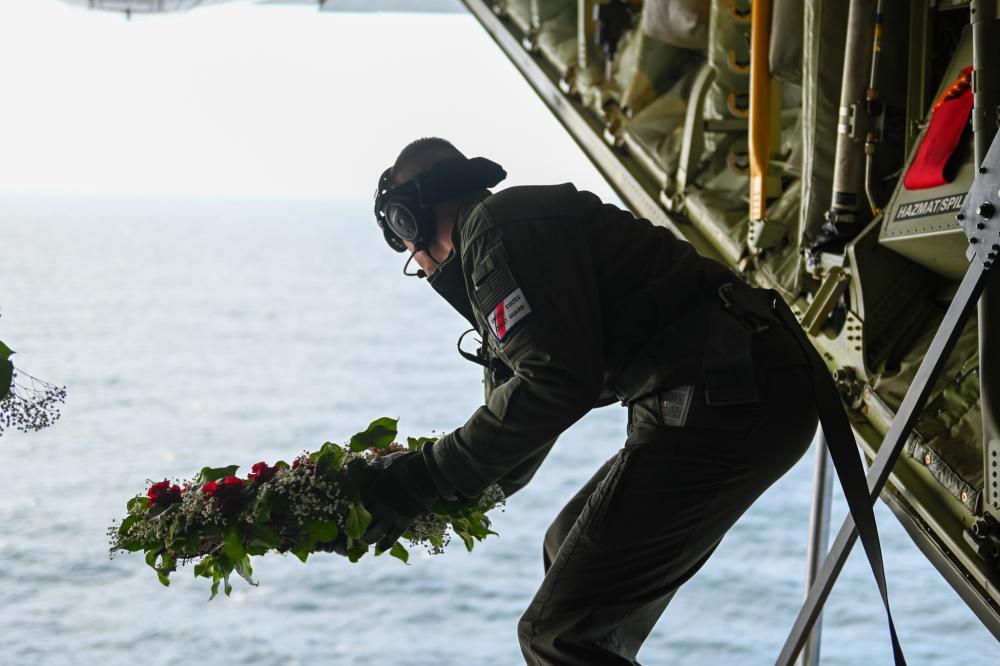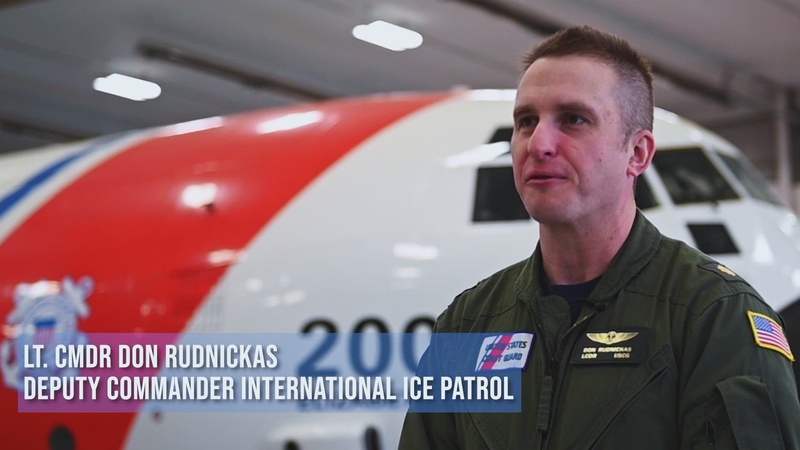Imagery Available: International Ice Patrol - Remembering the Titanic 110 years later
U.S. Coast Guard sent this bulletin at 05/11/2022 01:20 PM EDT
| Feature Story |
U.S. Coast Guard Atlantic Area |
International Ice Patrol: Remembering the Titanic 110 years later
Editors' Note: To view video or download high-resolution imagery, click on the photos above.
by Petty Officer 3rd Class Kim Reaves
Water stretches as far as the eye can see, and the air is chilled. The ocean’s surface is studded with memorial wreaths as the shadow of a fixed-wing plane passes just ahead. This is the sight of the famous sinking of the Royal Mail Ship Titanic. The ship met its tragic fate at the hands of an iceberg 110 years prior.
When the seemingly unsinkable Titanic slipped below the waves on April 15, 1912, killing 1,505 people aboard, the loss of life was devastating. The disaster, however, evoked the conception of the international ice patrol to monitor the presence of icebergs in the Atlantic and Sub-Arctic Oceans and report their movements for safety purposes. This mission continues to this day, conducted by the U.S. Coast Guard and partners.
“The International Ice Patrol (IIP) was officially established in 1913 to monitor the iceberg danger in the North Atlantic Ocean and provide relevant iceberg warning products to the maritime community,” said Lt. Cmdr. Don Rudnickas, the deputy commander for the U.S. Coast Guard International Ice Patrol. “Icebergs continue to be a threat today, and the U.S Coast Guard continues to carry out the International Ice Patrol on behalf of the maritime nations that conduct trade across the Atlantic in accordance with international treaties.”
The mission of the IIP today is to promote safe navigation of the North Atlantic Ocean during the ice season, which runs from February 1 through July 31, when the danger of iceberg collision is greatest. The IIP monitors the iceberg danger during this time and provides relevant iceberg warning products daily to the maritime community.
The IIP’s most recent operation included the crew’s routine locating and logging of icebergs in the trans-Atlantic shipping lanes and deploying a Surface Velocity Program Drifting Buoy into the channel to monitor currents. The week-long reconnaissance patrol of the North Atlantic Ocean led the crew to search the Grand Banks of Newfoundland area to locate icebergs and monitor the extent of iceberg danger. It’s a unique and lesser-known mission of the U.S. Coast Guard.
This trip also included an additional mission, honoring the lives lost during the Titanic tragedy by participating in a ceremony commemorating the 110th anniversary of the sinking of the Titanic in Halifax, Nova Scotia. The crew’s first stop was in Halifax to kick off the multi-mission patrol. They were greeted by the welcoming faces of the Titanic Society of Atlantic Canada at the Local Women’s Council house. A sense of melancholy and reverence filled the room as the events of the Titanic were revisited.
“One of the most famous tragedies in history, the sinking of the Titanic, continues to teach us lessons,” said Councilor Rebecca Kent, a member of the Halifax Regional Municipality District 3. “Lessons about being prepared and adhering to the warnings and the information shared with us.”
The crew toured the cemetery where many of those lost passengers and crew aboard the Titanic were laid to rest. They then departed for St. John's, Newfoundland, and en route, deployed four memorial wreaths blessed by a priest during the ceremony in Halifax, at the site of the Titanic’s iceberg collision. The wind carried the wreaths as they left the U.S. Coast Guard HC-130 Hercules airplane ramp and landed gently on the cold water that was filled with tragedy more than a century ago. The crew’s next task, patrol for the next week and confirm reports on iceberg movement to prevent another disaster.
Taking off from Newfoundland in the Hercules on April 22, the crews of the IIP and the U.S. Coast Guard Air Station Elizabeth City-based Hercules were eager to begin finding icebergs. Still, the day's first task was deploying a Surface Velocity Program Drifting buoy from the aircraft into the ocean.
Safely strapped into the aircraft by gunner’s belts, two aircrew members opened the rear ramp of the Hercules, letting in a wall of frigid North Atlantic air. The crew members deployed the buoy with one swift push out the back of the plane. A bright orange parachute opened to allow for the safe deposit of the buoy into the ocean. The crew was ecstatic about the ideal outcome of the evolution. It was a success!
“For us to effectively predict where the icebergs will drift, we need to know what the ocean currents are doing at the 50-meter depth,” said Rudnickas. “So, today, we dropped an oceanographic buoy. The buoy will float in the water carried by the currents at the 50-meter depth where the majority of an iceberg’s mass sits, and we will track its position as an input to our drift model.”
After the successful buoy deployment, the crews began iceberg reconnaissance over the Labrador Current, which carries icebergs from Greenland and Eastern Canada’s glaciers toward the Trans-Atlantic shipping lanes. Over approximately eight hours, the crew observed 239 icebergs of varying sizes drifting southward.
“Icebergs are still a real hazard to trans-Atlantic shipping,” said Rudnickas. “Our job is to mitigate the risk by going up to find these icebergs and sending out a daily iceberg limit to warn ships at sea.”
The iceberg observations are sent back to the IIP Operations Center in Suitland, Maryland. A computer model uses ocean currents provided by the buoy and other environmental data to predict iceberg drift and deterioration. Established by the first Safety of Life at Sea (SOLAS) convention in 1914, the International Ice Patrol operates today under regulations outlined in SOLAS by the International Maritime Organization (IMO) and the federal statutes codified in Title 46, Section 738a. Seventeen nations' signatory funds the International Ice Patrol to the SOLAS agreement.
The periodic searching of nearly 500,000 square miles of ocean is just one part of a much larger monitoring apparatus requiring an in-depth understanding of the dynamic weather and ocean currents on the Grand Banks; monitoring and predicting the movements of thousands of icebergs; continuous operation of a sophisticated computer model known as the Berg Analysis and Prediction System (BAPS); transmission of warnings and ice charts to ships at sea in a host of different formats; and nearly daily cooperation with over 30 organizations and agencies in the United States, Canada, and Europe.
The IIP initially relied on ships to gather data, but after World War II transitioned to aircraft. As technology continues to advance, the program is being modernized. The Department of Homeland Security (DHS) Science and Technology Directorate (S&T) is partnering with Service and the IIP to augment the U.S. Coast Guard's ability to protect infrastructure and improve maritime safety and navigation in the Arctic region by fusing satellite-based radar imagery and commercial Synthetic Aperture Radar (SAR) imagery with ship reporting systems to enable analysts to identify significant ice throughout the North Atlantic Ocean in real-time.
Although the IIP was founded due to a historic disaster, the U.S. Coast Guard women and men who serve in the IIP today and partner nations understand the importance of protecting global shipping and the environment and ultimately lives through this work. Their commitment mitigates the risk of another tragedy like the Titanic sinking.
-USCG-




